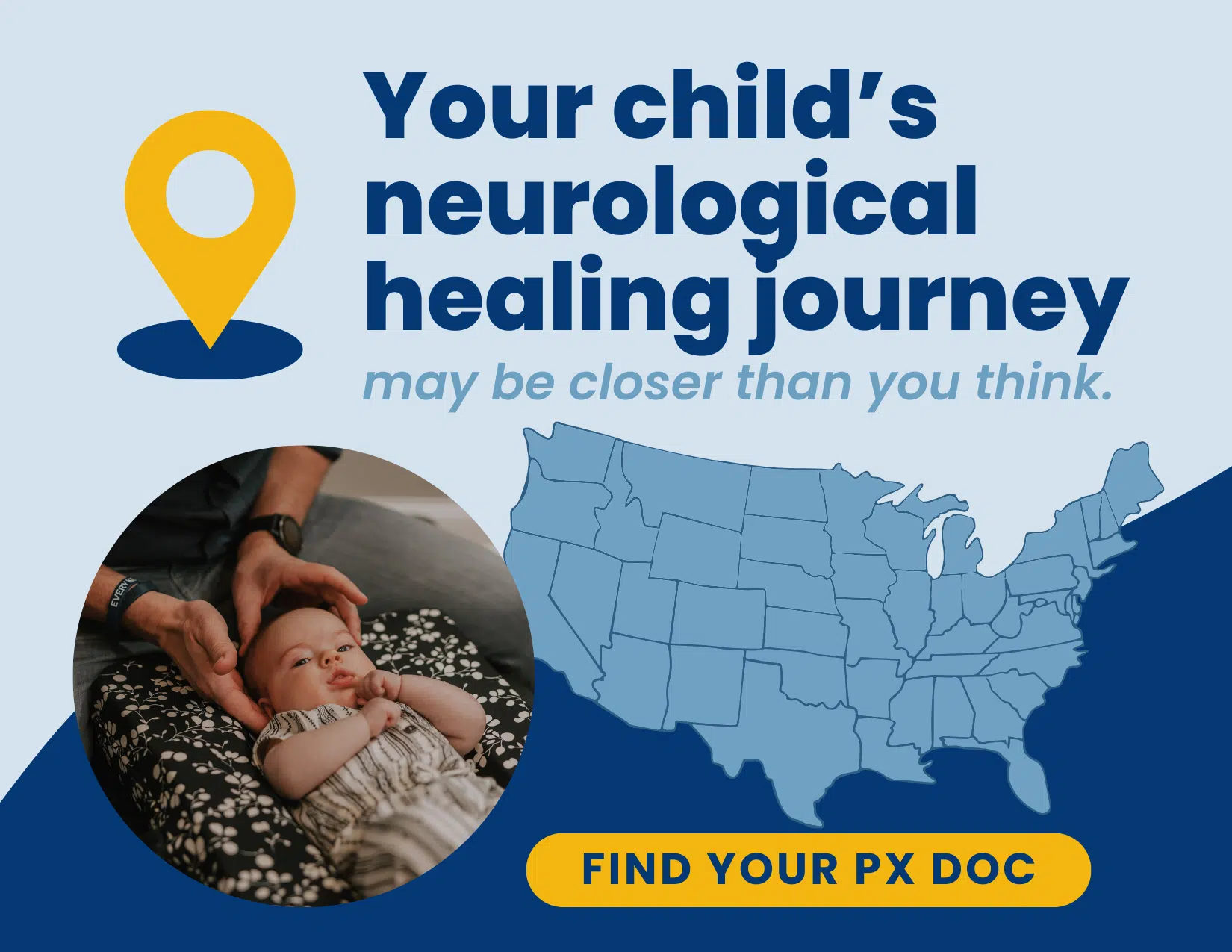Ever noticed how a baby can seem perfectly content in their mother’s arms, yet become fussy when passed to someone else? This isn’t just coincidence—it’s a profound neurological process called co-regulation. They have only known their moms their entire life and have interacting with her nervous system for the past 9+ months!
According to research, up to 15% of infants experience regulation difficulties in their first year, affecting sleep, feeding, and persistent crying. Yet many healthcare providers focus solely on the baby’s behavior without considering the crucial nervous system connection between mother and child.
As parents, you may have felt frustrated trying to calm your distressed baby despite using every technique in parenting books. Your pediatrician may have told you that it’s your breast milk or to try a new formula. Maybe they suggested taking out dairy or gluten or even legumes! Some say to not use any caffeine or try holding them in a different position. All of this may play a role in colic… But what if the answer lies not in more techniques, but in understanding the neurological dance happening between you and your baby?
In this article, we’ll dive into co-regulation, how a mother’s nervous system influences her baby’s development, and how Neurologically-Focused Chiropractic Care can help restore balance to both nervous systems.
What is Co-Regulation Between Mom and Baby?
Co-regulation is the biological process through which a regulated adult’s nervous system helps regulate an infant’s developing nervous system. While many parents understand the emotional connection with their baby, fewer realize this bond has profound neurophysiological implications.
Co-regulation helps your baby’s developing nervous system manage physiological and emotional responses to external stimuli, ultimately leading to self-regulation.
When a baby is born, their nervous system is underdeveloped BY DESIGN. Unlike regulated adults who can calm themselves, babies depend on mom’s nervous systems to regulate their physiological states. When your baby is distressed, their nervous system seeks yours as a template for returning to balance. Your calm presence provides the neurological pattern their developing brain needs. We see this in real time with breastfeeding and skin-to-skin contact.
Skin-to-skin contact demonstrates this beautifully. It’s been found that when a mother holds her baby against her skin, the baby’s heart rate, breathing patterns, and stress hormone levels begin to regulate. Research shows babies receiving regular skin-to-skin contact have increased breast feeding initiation, better temperature regulation, and less crying.
Unfortunately, prenatal stress, anxiety, birth trauma, and physical tension can disrupt this natural process, creating neurological dysfunction that interferes with effective co-regulation.
How Baby’s Nervous System Learns from Mom’s
The nervous system is the first major system to develop in a baby, beginning to form already at the 3rd and 4th week of pregnancy.. That’s before most moms even find out that they are pregnant! This early development highlights the nervous system’s critical importance as the master control system for all other developing functions.
A mother’s nervous system state serves as the blueprint for her baby’s developing nervous system. Before and throughout pregnancy, the mother’s stress levels, emotional well-being, and Autonomic Nervous System balance may influence the development of these same systems in her baby.
This connection happens through hormonal exchanges. When a mother experiences chronic stress, her body produces stress hormones like cortisol that become exposed to baby in utero. This occurs through the umbilical cord. The baby’s developing brain and nervous system adapt to this environment, essentially “learning” that the world is stressful. Conversely, when a mother’s nervous system is balanced, her baby receives signals that the world is safe. This teaches baby how to flow through a stressful vs safe environment and start to learn how to adapt.
This neurological programming is key to what we call “The Perfect Storm“—the events of early life stressors contributing to nervous system dysregulation. High fertility stress, mom and dad’s exposure to birth control, medications, endocrine disruptors, and stress before conception, high maternal stress during pregnancy, followed by birth interventions that physically impact the baby’s delicate neurospinal system, can lead to patterns of subluxation and dysautonomia affecting a baby and eventually child’s ability to self-regulate. And instead of that baby growing out of colic and constipation, we see them grow into diagnoses like ADHD, asthma, anxiety and more as a child and teenager… Leading to a worn out and wound up adult. Which is why we want to get ahead of this storm.
The Nervous System Connection
To understand co-regulation, we must explore the Autonomic Nervous System (ANS)—the control center for our body’s unconscious functions. The ANS has two primary branches: the Sympathetic Nervous System (“fight or flight”) and the Parasympathetic Nervous System (“rest, digest, and regulate”).
Think of the sympathetic system as your body’s gas pedal—revving up heart rate and stress hormones when you perceive danger. The parasympathetic system acts as your brake pedal—slowing things down and promoting relaxation. In a healthy person, these systems shift fluidly. However, chronic stress or physical tension can disrupt this balance, leaving a person stuck in sympathetic dominance.
Babies are remarkably attuned to their parents’ nervous system state, especially mom’s, detecting subtle cues through facial expressions, voice tone, and touch quality. When a mother holds her baby, the infant reads her heart rate, breathing pattern, and stress hormone levels. This is why an anxious parent trying to soothe a baby while saying “calm down” often experiences frustration—the baby responds to the parent’s actual nervous system state, not their words. This is also why we sing to our sweet babies. It’s not only for them… It’s to help activate our vagus nerve to calm our nervous system too. But without an already regulated nervous system, this tends to not work as well.
So let’s talk vagus nerve! At the core of this regulatory system is the vagus nerve, essential for activating the calming “rest and regulate” response. When functioning optimally, it allows both parent and child to maintain balance. However, dysfunction of the vagus nerve—often due to subluxation in the upper neck and brainstem region—can significantly impair both mother and baby’s ability to regulate.
Why Co-Regulation Matters in the Early Years
The first three years of life represent a critical period for brain development, with more than 1 million new neural connections formed every second during these early years.
Co-regulation during this crucial time is foundational to healthy neurological development. Every time a mom helps a baby move from distress to calm, they’re strengthening those neural pathways that will eventually allow the child to self-regulate.
The impacts of co-regulation extend to nearly every aspect of childhood development:
- Sleep patterns: A well-regulated nervous system is essential for healthy sleep cycles.
- Feeding behaviors: The vagus nerve controls many aspects of digestion. When regulated, babies typically show improved feeding and fewer issues with reflux or colic.
- Emotional development: Co-regulation builds the foundations of emotional security and trust.
- Behavioral regulation: Co-regulation experiences in infancy directly influence a child’s ability to manage frustration and adapt to change.
It’s crucial to understand that struggles with co-regulation aren’t about parenting skill—they’re fundamentally about nervous system function.
Barriers to Effective Co-Regulation
While co-regulation should be natural and intuitive, many modern families struggle with it. Understanding the neurological barriers can help parents move beyond guilt to find real solutions.
The most common barriers stem from nervous system dysregulation in either the parent, the baby, or both. For mothers, this often begins during pregnancy or birth. High stress during pregnancy floods the developing baby with stress hormones, and can lead to disrupted development. Birth interventions can create physical trauma and tension in the delicate neurospinal structures of both mother and baby.
This physical tension can cause subluxation—areas of neurological dysfunction that interfere with proper nerve communication, particularly affecting the vagus nerve and autonomic balance. When subluxation affects the upper neck and brainstem regions, it can impact the body’s ability to switch from “fight or flight” to “rest and regulate” mode.
Other common barriers include:
- Maternal stress and history: A mother’s own childhood experiences with regulation directly impact her ability to co-regulate with her baby.
- Physical discomfort: Pain from birth recovery or tension in the neck and neurospine can maintain sympathetic dominance.
- Sleep deprivation: The exhaustion of new parenthood creates a vicious cycle, as sleep deprivation triggers sympathetic dominance.
- Environmental overwhelm: Excessive stimulation can overwhelm both parent and baby’s sensory systems.
The PX Docs Approach: Restoring Neurological Function
As PX Docs, we recognize that effective co-regulation requires addressing the root cause of nervous system dysregulation. Our Neurologically-Focused Chiropractic Care approach identifies and addresses the neurological dysfunction that may be interfering with a mother and baby’s ability to co-regulate effectively.
Our approach begins with comprehensive Neurological INSiGHT Scans that objectively measure nervous system function in both mother and baby. These scans provide a “window” into the Autonomic Nervous System, revealing patterns of subluxation and dysautonomia.
Heart Rate Variability (HRV) measurement is particularly valuable for assessing co-regulation. Research shows that when mother and baby are effectively co-regulating, using slow-paced diaphragmatic breathing techniques, their HRV patterns often synchronize. Our scanning technology can detect this synchronization—or lack thereof—helping to guide our care.
Based on these assessments, our doctors create personalized care plans that include gentle adjustments designed to address areas of subluxation and restore proper neurological function. As neurological function improves, many families report remarkable improvements in co-regulation experiences.
Understanding Co-Regulation Scans
One of the remarkable advancements in our understanding of the mother-baby connection is through Heart Rate Variability (HRV). These specialized assessments reveal fascinating patterns in autonomic nervous system function between mothers and their infants.
When mother and baby are successfully co-regulating, their HRV patterns often synchronize, with both plotting in the same quadrant on our assessment charts. This neurophysiological harmony is visible in the scan results, where the white indicator dot appears in remarkably similar positions for both mother and infant during postpartum evaluations. While research in this area continues to evolve and we surely do need more of it, our clinical observations consistently demonstrate this synchronization pattern in well-regulated pairs.
The first scan shows the mother’s HRV pattern, while the second shows her baby’s during a postpartum evaluation.
Neurologically-Focused Chiropractic Care works directly with these patterns, helping to restore optimal function in both parent and child. By addressing neurological subluxation and promoting parasympathetic balance through gentle adjustments, we can significantly enhance the co-regulation capacity between mother and baby—creating healthier, more harmonious relationships from the earliest stages of life.
Practical Ways to Support Co-Regulation at Home
While addressing the underlying neurological function is foundational, there are many practical ways to support co-regulation at home after the nervous system is balanced and has gone through its initial care plan with a PX Doc:
- Deep breathing while holding baby: Your breathing pattern directly influences your baby’s, helping both shift from sympathetic to parasympathetic states.
- Skin-to-skin contact: Try at least 15-20 minutes daily, perhaps during feeding or before nap time. There is no age limit to this working as many believe it is just newborns but all babies can benefit.
- Eye contact and rhythmic movement: The combination helps synchronize your nervous systems.
- Singing to your baby: Your voice has a powerful regulating effect on you and your baby’s nervous systems.
- Mindful presence during distress: Maintain your own regulation while acknowledging their distress.
- Breastfeeding as regulation: The close contact, skin-to-skin connection, and rhythmic sucking all contribute to autonomic regulation.
- Create a regulation-friendly environment: Reduce unnecessary sensory input by keeping the environment calm.
These practices become significantly more effective when both nervous systems are functioning optimally.
Empowering Families Through Neurological Balance
The journey of parenting brings both profound joy and significant challenges. Understanding the neurological dance of co-regulation offers a perspective that can transform your experience.
When we address the root cause of co-regulation difficulties by focusing on nervous system function, we move beyond temporary fixes to create lasting neurological resilience. A well-regulated nervous system doesn’t just make today easier; it builds the foundation for your child’s lifelong ability to manage stress and form meaningful relationships.
If you’ve been struggling with a baby who seems difficult to soothe or simply want to optimize your connection with your child, consider exploring how Neurologically-Focused Chiropractic Care might support your family’s well-being.
To find a qualified PX Doc in your area who specializes in supporting mothers and babies, visit our PX Docs Directory. Your family deserves care that addresses the root cause, empowering you to create the connected, regulated relationship that instinctively feels right but may have seemed frustratingly out of reach.





